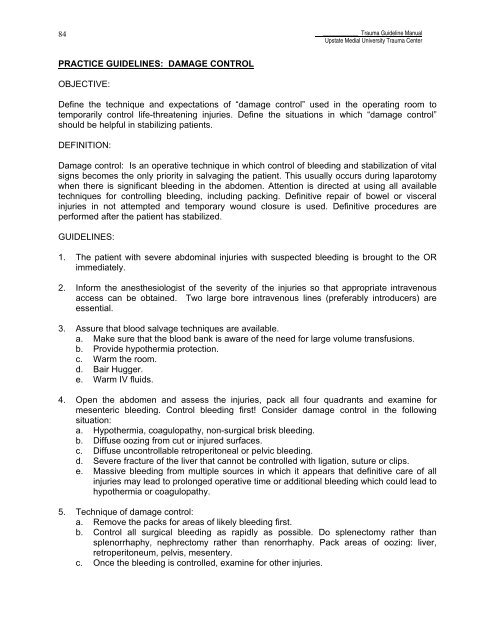Trauma Guideline Manual - SUNY Upstate Medical University
Trauma Guideline Manual - SUNY Upstate Medical University
Trauma Guideline Manual - SUNY Upstate Medical University
You also want an ePaper? Increase the reach of your titles
YUMPU automatically turns print PDFs into web optimized ePapers that Google loves.
84____________ <strong>Trauma</strong> <strong>Guideline</strong> <strong>Manual</strong><strong>Upstate</strong> Medial <strong>University</strong> <strong>Trauma</strong> CenterPRACTICE GUIDELINES: DAMAGE CONTROLOBJECTIVE:Define the technique and expectations of “damage control” used in the operating room totemporarily control life-threatening injuries. Define the situations in which “damage control”should be helpful in stabilizing patients.DEFINITION:Damage control: Is an operative technique in which control of bleeding and stabilization of vitalsigns becomes the only priority in salvaging the patient. This usually occurs during laparotomywhen there is significant bleeding in the abdomen. Attention is directed at using all availabletechniques for controlling bleeding, including packing. Definitive repair of bowel or visceralinjuries in not attempted and temporary wound closure is used. Definitive procedures areperformed after the patient has stabilized.GUIDELINES:1. The patient with severe abdominal injuries with suspected bleeding is brought to the ORimmediately.2. Inform the anesthesiologist of the severity of the injuries so that appropriate intravenousaccess can be obtained. Two large bore intravenous lines (preferably introducers) areessential.3. Assure that blood salvage techniques are available.a. Make sure that the blood bank is aware of the need for large volume transfusions.b. Provide hypothermia protection.c. Warm the room.d. Bair Hugger.e. Warm IV fluids.4. Open the abdomen and assess the injuries, pack all four quadrants and examine formesenteric bleeding. Control bleeding first! Consider damage control in the followingsituation:a. Hypothermia, coagulopathy, non-surgical brisk bleeding.b. Diffuse oozing from cut or injured surfaces.c. Diffuse uncontrollable retroperitoneal or pelvic bleeding.d. Severe fracture of the liver that cannot be controlled with ligation, suture or clips.e. Massive bleeding from multiple sources in which it appears that definitive care of allinjuries may lead to prolonged operative time or additional bleeding which could lead tohypothermia or coagulopathy.5. Technique of damage control:a. Remove the packs for areas of likely bleeding first.b. Control all surgical bleeding as rapidly as possible. Do splenectomy rather thansplenorrhaphy, nephrectomy rather than renorrhaphy. Pack areas of oozing: liver,retroperitoneum, pelvis, mesentery.c. Once the bleeding is controlled, examine for other injuries.
















